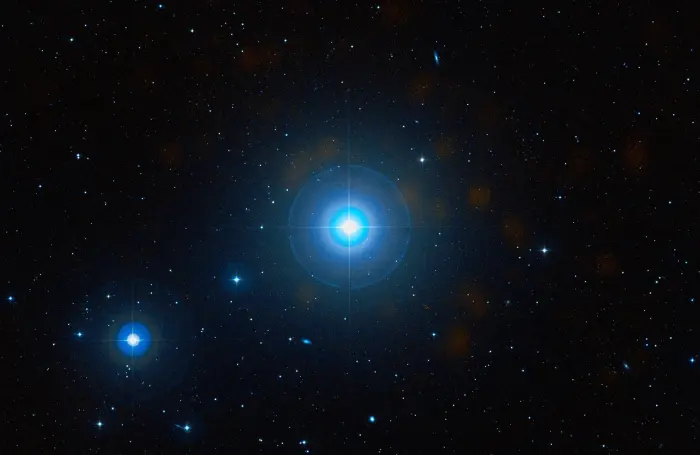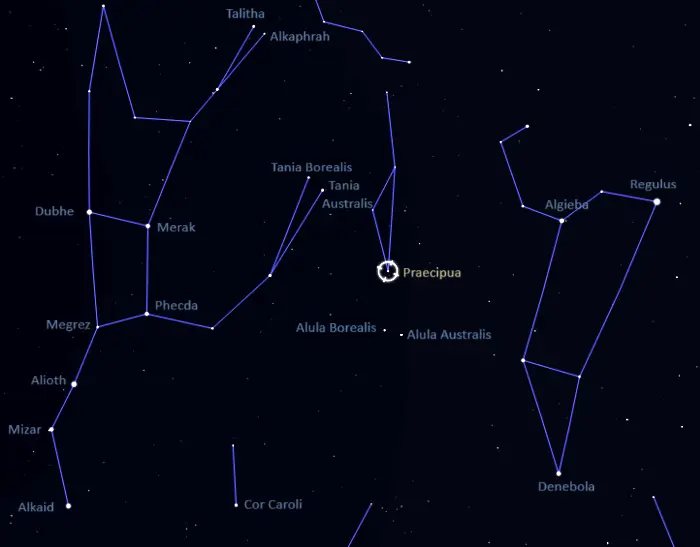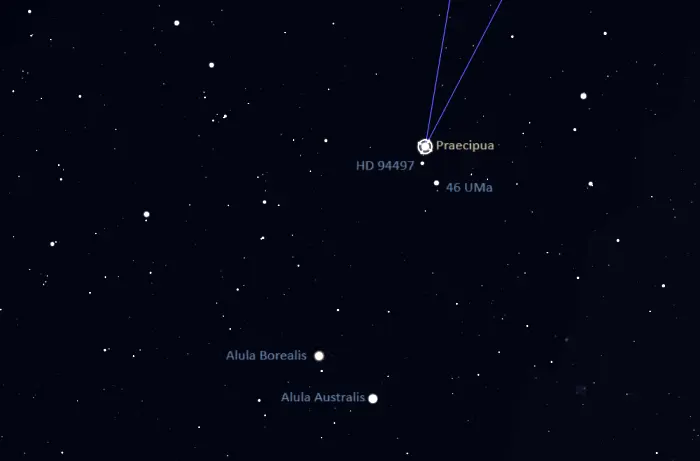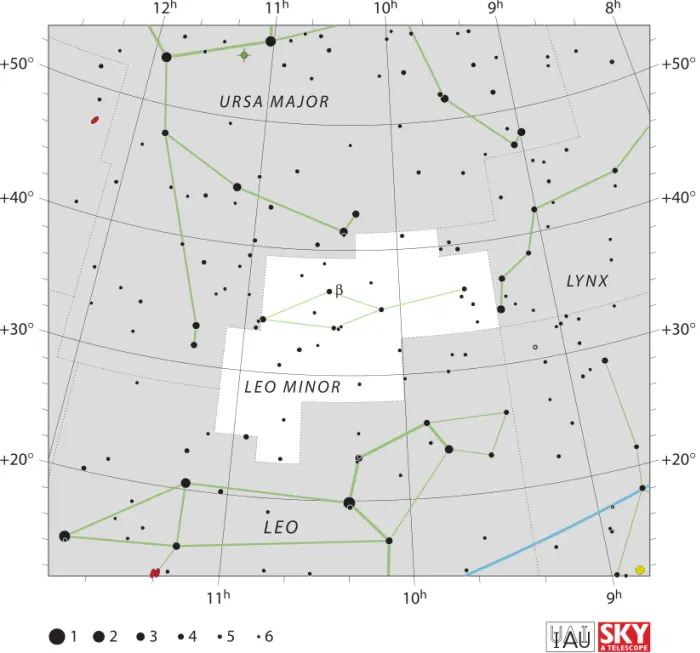Praecipua, 46 Leonis Minoris (46 LMi), is an evolved red clump giant located 94.9 light-years away in the constellation Leo Minor. With an apparent magnitude of 3.83, it is the brightest star in Leo Minor. It lies in the region of the Great Bear’s feet.
Star type
Praecipua is an orange giant or subgiant star of the spectral type K0+ III-IV. In terms of evolution, it is a red clump giant, an evolved star that is slightly hotter than other red giants with the same luminosity.
Red clump giants are stars on the horizontal branch (HB) that fuse helium in their core and hydrogen in a shell around the core. These stars have undergone a helium flash, a brief runaway event that kickstarts helium fusion. Other bright stars at this evolutionary stage include Capella in the constellation Auriga, Ain in the Hyades cluster in Taurus, Diphda in Cetus, and Schedar in Cassiopeia.
Praecipua has a mass of 1.69 solar masses and a radius 8.22 times that of the Sun. With an effective temperature of 4,670 kelvin, it is around 34 more luminous than the Sun. It spins at 1.81 km/s. The star is older than the Sun, with an estimated age of 6.76 billion years.
Praecipua is classified as a suspected variable star. Its brightness has been observed to vary by around 0.05 magnitudes, from magnitude 3.79 to 3.84.

Praecipua (46 Leonis Minoris), image: Wikisky (DSS)
Name
The name Praecipua (pronunciation: /prɪˈsɪpjʊə/) comes from the Latin word for “the Chief (Star of Leo Minor).” 46 Leonis Minoris is the lucida (brightest star) in the constellation Leo Minor.
The name may have originally been assigned to 37 Leonis Minoris, which is now the constellation’s fifth brightest star, and later used for 46 LMi by mistake.
The International Astronomical Union’s (IAU) Working Group on Star Names (WGSN) approved the name Praecipua for 46 Leonis Minoris on June 30, 2017.
In Chinese astronomy, Praecipua was known as 勢四, “the Fourth (Star) of the Eunuch.” Eunuch was an asterism formed by Praecipua with 34 Leonis Minoris, 33 Leonis Minoris, and 42 Leonis Minoris. The asterism was part of the larger Purple Forbidden Enclosure, which represented the imperial palace.
Location
Praecipua lies between the Big Dipper and the Sickle of Leo, in the region of the Three Leaps of the Gazelle. The Three Leaps is an asterism formed by the six stars that mark the feet of the Great Bear: Talitha, Alkaphrah, Tania Borealis, Tania Australis, Alula Borealis, and Alula Australis.
Praecipua can be found by extending a line from the stars of the Second Leap, Tania Borealis through Tania Australis. Alternatively, it lies along the imaginary line extended from Regulus, the brightest star in Leo, through Algieba, the second brightest star in the Sickle of Leo.
Praecipua forms a small, faint triangle with HD 94497 (mag. 5.70) and 46 Ursae Majoris (mag. 5.00) in the constellation Ursa Major.

The location of Praecipua (46 Leonis Minoris), image: Stellarium

Praecipua location, image: Stellarium
Constellation
Praecipua is located in the constellation of Leo Minor (the Smaller Lion), on the border with Ursa Major (the Great Bear). Representing the Lesser Lion (or the Smaller Lion), Leo Minor is one of the smallest northern constellations. Located between the larger Ursa Major and Leo (the Lion), it stretches across 232 square degrees and is the 64th largest of the 88 constellations.
Leo Minor is not one of the Greek constellations. It was created by the Polish astronomer Johannes Hevelius in the 17th century. Hevelius created 10 of the modern 88 constellations and several that are now obsolete. He used the proper name Praecipua (Latin for chief, leader, first, or head) for the constellation’s brightest star. Leo Minor is not associated with any myths.

Leo Minor constellation, image credit: IAU and Sky & Telescope magazine (Roger Sinnott & Rick Fienberg) (CC BY 3.0)
Leo Minor is one of the faintest constellations in the sky. Praecipua has a visual magnitude of 3.83, and only five other stars in the constellation are brighter than magnitude 5.0. Notable stars in Leo Minor include the yellow giant or subgiant Beta Leonis Minoris, the variable yellow giant 10 Leonis Minoris, the yellow bright giant 37 Leonis Minoris, the red giant 8 Leonis Minoris, and Illyrian (HD 82886), a yellow subgiant with an orbiting planet.
Deep sky objects in Leo Minor include the spiral galaxies NGC 3432, NGC 3021, NGC 3003, NGC 3344, NGC 3504, and NGC 3486, the lenticular galaxy NGC 2859, the interacting pair Arp 107, and Hanny’s Voorwerp (Hanny’ Object), a quasar ionization echo near the spiral galaxy IC 2497.
The best time of the year to see the stars and deep sky objects in Leo Minor is during the month of April, when the constellation appears higher above the horizon in the early evening. The entire constellation is visible from locations between the latitudes 90° N and 45° S.
The 10 brightest stars in Leo Minor are Praecipua (46 LMi, mag. 3.83), Beta Leonis Minoris (mag. 4.21), 21 Leonis Minoris (mag. 4.50), 10 Leonis Minoris (mag. 4.54), 37 Leonis Minoris (mag. 4.68), 30 Leonis Minoris (mag. 4.72), 41 Leonis Minoris (mag. 5.08), 42 Leonis Minoris (mag. 5.35), 8 Leonis Minoris (mag. 5.37), and 20 Leonis Minoris (mag. 5.40).
Praecipua – 46 Leonis Minoris
| Spectral class | K0+ III-IV |
| Variable type | Suspected |
| Apparent magnitude | 3.83 (3.79 – 3.84) |
| Absolute magnitude | +1.45 |
| Distance | 94.9 ± 0.6 light years (29.1 ± 0.2 parsecs) |
| Parallax | 32.9210 ± 0.1775 mas |
| Radial velocity | 15.69 ± 0.19 km/s |
| Proper motion | RA: +90.625 ± 0.145 mas/yr |
| Dec.: -278.664 ± 0.140 mas/yr | |
| Mass | 1.69 M☉ |
| Luminosity | 34.2 L☉ |
| Radius | 8.22 ± 0.22 R☉ |
| Temperature | 4,670 K |
| Metallicity | -0.20 dex |
| Age | 6.76 billion years |
| Rotational velocity | 1.81 km/s |
| Surface gravity | 2.96 cgs |
| Constellation | Leo Minor |
| Right ascension | 10h 53m 18.6891667765s |
| Declination | +34° 12′ 53.611679098″ |
| Names and designations | Praecipua, 46 Leonis Minoris, 46 LMi, HD 94264, HR 4247, HIP 53229, SAO 62297, FK5 412, BD+34 2172, AG+34 1112, GC 14961, GCRV 6745, LTT 12905, NLTT 25614, PPM 75534, IRC +30226, JP11 2003, NSV 4999, LSPM J1053+3412, PLX 2532.00, GSC 02521-02271, TIC 85321185, RAFGL 1440, ASCC 585315, IRAS 10505+3428, 2MASS J10531870+3412538, UBV 9986, UBV M 16582, USNO-B1.0 1242-00184835, TYC 2521-2271-1, Gaia DR2 738259665062173440, Gaia DR3 738259665062428416 |